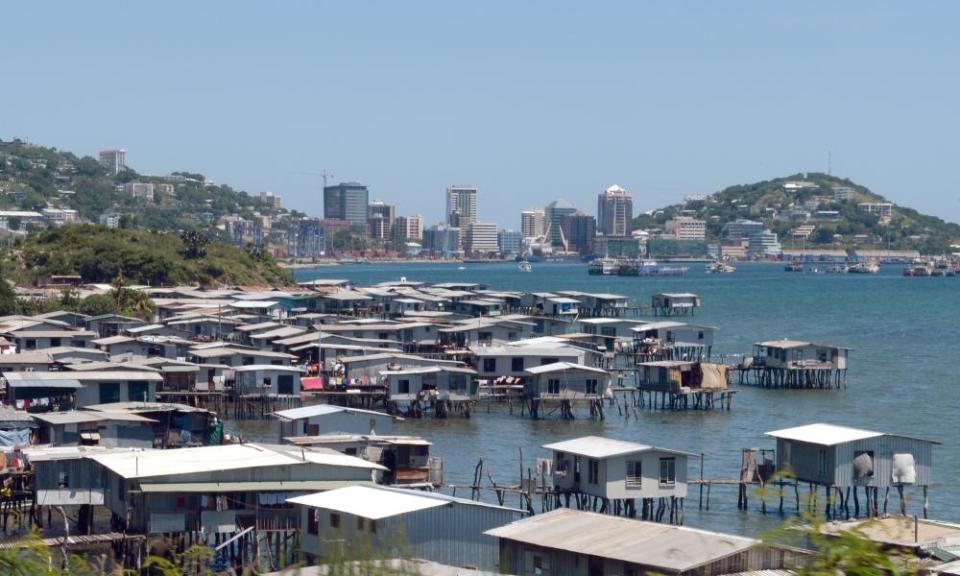Bright lights, big problems: hardship hits career dreams of Pacific youth
Jim Pia is awake at five each morning to catch the first bus into the city.
Daily, the 20-year-old fights for a space on the bus from the Bushwara settlement, on the outskirts of Port Moresby, to ensure he is on time to secure a place within the capital’s Gordons Market.
From 8am, when the market gates open, to late in the afternoon, Pia quietly sells his wares – men’s and women’s shoes. This, unintentionally, has become his daily routine.
“It’s been two years since I completed my studies and came to Port Moresby in search of my dream,” he tells the Guardian from his stall.
Having finished year 12, Pia took his education further, completing a diploma in sales and marketing from Kokopo Business College on Papua New Guinea’s New Britain Island. He is saving to pay for a degree course.
But Pia can still not secure a steady job in Port Moresby despite scores of applications and dozens of interviews.
He is one among thousands of young Papua New Guineans who have left rural areas for the bright lights of the big city.
Pia is also characteristic of the Pacific’s youthful demographic, known as the “youth bulge” , which could prove a dividend for growth and development, or a timebomb that threatens civil unrest and instability, a new Lowy Institute report argues.
The Pacific is one of the youngest regions on earth – fully half of the region is aged under 23 – and it will remain young for decades to come. With birth rates in some nations nearly double the global average, the youth bulge is not expected to peak until the middle of the century.

The phenomenon is especially acute in the Pacific’s most populous Melanesian countries, Papua New Guinea, Solomon Islands, and Fiji, where a third of people are aged 14 and under.
Educated and employed, a large young cohort could power Pacific economies and their development.
But the prospect of that cohort emerging into adulthood with poor education, low skills and few employment prospects raises the risk of civil unrest and social instability.
Alongside climate change, disaster resilience and recovery from the Covid-19 pandemic, the Pacific’s demographics present one of its greatest challenges, the Lowy paper argues.
“Economic prosperity, political success and social stability in the Pacific Islands region in the future will depend on harnessing this demographic dividend and preventing youth marginalisation and disillusionment,” report author Catherine Wilson writes.
“An abundance of young people could drive social and human development, innovation, and economic growth, if education systems respond to the demand and if the energy, skills, and leadership potential of youth are leveraged. On the other hand, if young people become over-represented among the unemployed and disenfranchised, the odds of increased poverty, disaffection, social instability, and conflict are high.”
The quality of education, particularly in rural areas, remains a serious issue
Catherine Wilson, report author
The population of the 22 independent states and territories of the Pacific is predicted to increase from 11.9 million currently to 19.7 million by 2050, straining countries’ health, education, and housing infrastructures, and potentially leaving millions food insecure, without land or work.
Birth rates are high across the region, driven by enduring cultural traditions of large families, religious convictions, variable take-up of contraception and difficulty in accessing reproductive health services. In PNG the birth rate is 4.4 babies per woman, and 65 births per 1,000 girls or women aged 15 to 19, far above the global averages of 2.4 and 44 respectively.
Wilson told the Guardian that the phenomenon of urban drift, where young rural islanders move to cities seeking employment, was too often a case of “bright lights, disappointed dreams”.
“A lot of youth go to cities because they see these places will bring them more affluence, they’ll have money, jobs, more exciting, modern lifestyles, and entertainment. For some it comes true, but for many who go to Port Moresby or Honiara, if they do not have the education or the skills to get the job they want, they become caught up in a cycle of urban poverty.”
The Asian Development Bank has argued the phenomenon is driving the “urbanisation of poverty”, with unplanned settlements marked by income inequality, overcrowding, substandard housing, social exclusion and high unemployment. Governments struggle to provide even the most basic services – such as running water – to informal settlements.
“These factors can be catalysts for urban crime, violence, and personal insecurity, all of which are present in varying degrees in the cities of Port Moresby, Port Vila, and Honiara,” the Lowy report says.
Wilson said many Pacific countries had worked hard to meet their millennium development goals on increasing attendance in schools. But the quality of education in many Pacific states still lagged, so that literacy rates remained low, particularly in rural areas or on remote islands.
“The quality of education, particularly in rural areas, remains a serious issue. And that’s around teacher training, teaching resources, or physical infrastructure. Students are going all the way through school but coming out with low literacy levels. And without skills they fall back into the informal economy.”
At Gordon’s Market, Pia says he believes educational institutions are producing large numbers of graduates, but not those with skills needed by industry.
He tries to stay optimistic, he says, though he admits his experience of the city – for all that it promised – has been chastening.
“Sometimes I don’t get customers at all as there are other sellers who are selling similar items. They are just like me.”

 Yahoo News
Yahoo News 
